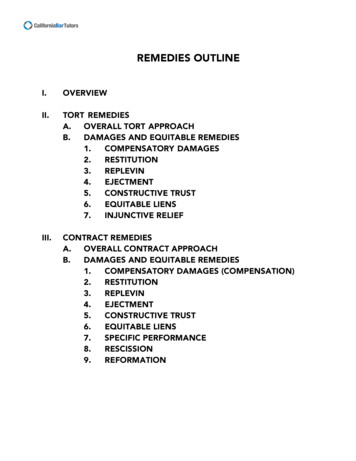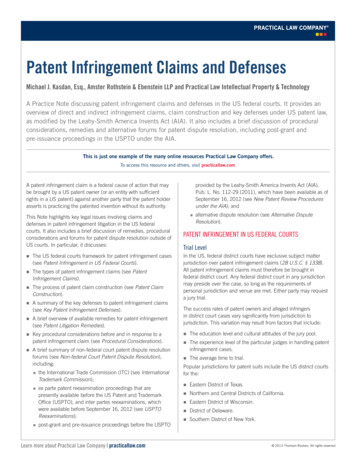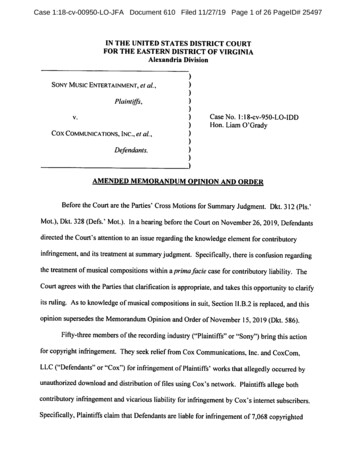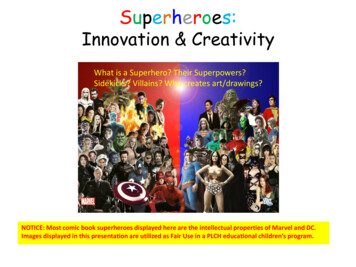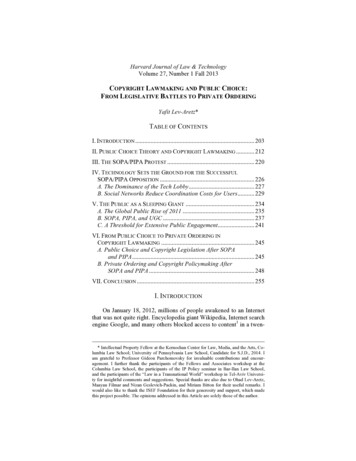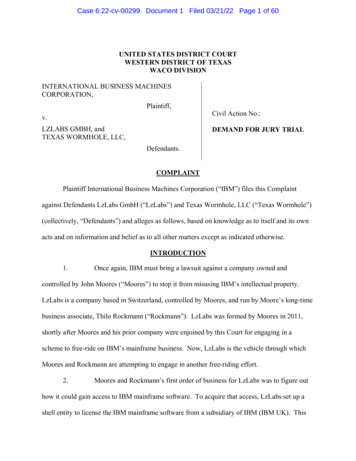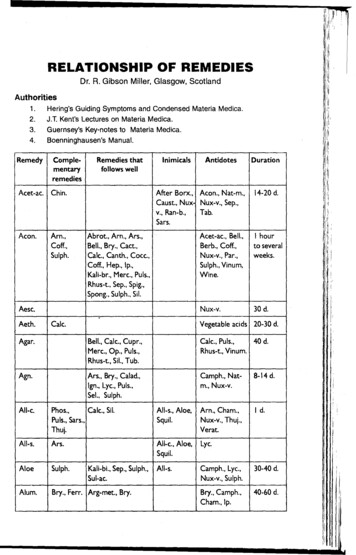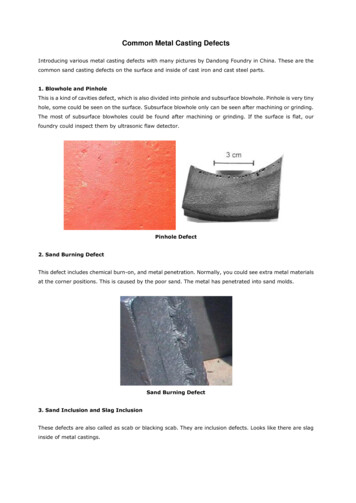
Transcription
DPIIT, MCI Chair on Intellectual Property Rights &Centre for Intellectual Property Rights Research and AdvocacyNational Law School of India University, Bangalore“REMEDIES AGAINST COPYRIGHT INFRINGEMENT”Under the Guidance ofProf. (Dr) T. Ramakrishna,MCI Chair Professor on IPRSubmitted ByRANGISETTI NAGA SUMALIKAInternSymbiosis Law School, Pune1
CertificateThis is to certify that Rangisetti Naga Sumalika, student from Symbiosis Law School,Pune, has successfully completed and submitted his report, Remedies againstCopyright Infringement. This has been submitted in fulfilment of his internship atthe Centre for Intellectual Property Research and Advocacy (CIPRA) during themonth of 1st January to 31st January 2021.Bangalore, 3rd February 2021Prof. (Dr.) T. RamakrishnaDPIIT, MCI Chair Professor of IPRResearch Associate2
DECLARATIONCertified that this research work is my original work and I have not borrowed anymaterial from other’s work nor have I presented this partly or fully to any otherinstitution/college/university.I have completed with all the formalities prescribed in this regardDate:3rd February 2021Place: BangaloreSignatureNAME3RANGISETTI NAGA SUMALIKA
REMEDIES AVAILABLE FOR COPYRIGHT INFRINGEMENTCopyright infringement is the use of works protected by copyright law without permission,infringing certain exclusive rights granted to the copyright holder, such as the right to reproduce,distribute, display or perform the protected work, or to make derivative works. The copyrightholder is typically the work's creator, or a publisher or other business to whom copyright has beenassigned. Copyright holders routinely invoke legal and technological measures to prevent andpenalize copyright infringement. Copyright infringement disputes are usually resolved throughdirect negotiation, a notice and take down process, or litigation in civil court. Egregious or largescale commercial infringement, especially when it involves counterfeiting, is sometimes prosecutedvia the criminal justice system. Shifting public expectations, advances in digital technology, and theincreasing reach of the Internet have led to such widespread, anonymous infringement thatcopyright-dependent industries now focus less onPursuing individuals who seek and share copyright- protected content online, and more onexpanding copyright law to recognize and penalize – as "indirect" infringers – the service providersand software distributors which are said to facilitate and encourage individual acts of infringementby others.The following are some of the commonly known acts involving infringement of copyright:a. Making infringing copies for sale or hire or selling or letting them for hire;b. Permitting any place for the performance of works in public where such performanceconstitutes infringement of copyrightc. Distributing infringing copies for the purpose of trade or to such an extent so as to affectprejudicially the interest of the owner of copyrightd. Public exhibition of infringing copies by way of trade; and Importation of infringing copiesinto IndiaCopyright is bothered about ensuring crafted by the human acumen. The area of copyright is theassurance of scholarly and imaginative works. These incorporate compositions, music, and works4
of the expressive arts, for example, artistic creations and figures, and innovation based works, forexample, PC programs and electronic information bases. The Berne Convention (1886), which isthe most established worldwide show administering copyright, expresses the accompanying in itsArticle 2: "The articulation 'abstract and masterful works' will remember each creation for thescholarly, logical and aesthetic space, whatever might be the mode or type of its appearance, forexample, books, handouts and different compositions; addresses, locations, lessons andThe different works of a similar sort; sensational or emotional melodic works; choreographic worksand excitements in stupid show; melodic structures with or without words; cinematographic worksto which are absorbed works communicated by a cycle practically equivalent to cinematography;works of drawing, painting, engineering, figure, etching and lithography; photographic works, towhich are acclimatized works communicated by a cycle comparable to photography; works ofapplied workmanship; outlines, maps, plans, representations and three-dimensional workscomparative with geology, geography, design or science. Interpretations, variations, plans of musicand different modifications of an abstract or aesthetic work will be secured as unique works withoutbias to the copyright in the first work. Assortments of abstract or masterful works, for example,reference books and compilations which, by reason of the choice and game plan of their substance,comprise scholarly manifestations will be secured accordingly, without bias to the copyright inevery one of the works shaping piece of such assortments." There is no prerequisite that the artisticand creative work ought to be acceptable or have imaginative benefits. It ought to, nonetheless, beunique. The specific significance of this prerequisite fluctuates from country to country, and it isregularly controlled by case law. By and large terms one may say that in nations having a placewith the precedent-based law convention almost no is required, other than that the work should notbe a duplicate of another work and that the creator ought to have shown a base measure ofexpertise, work and judgment in making it. In nations having a place with the common lawconvention, the prerequisite is regularly more grounded, for instance that the work should bear thestamp of the creator's character. An imaginative exertion would be needed from the creator thatmay go past simple expertise, work or judgment.The copyright act 1957 extends protection to original artistic works by conferring certain exclusiverights on the authors of the owners. In case of infringement the copyright owners have been5
bestowed upon certain remedies. There are three kinds of remedies available against infringementof copyright. They are civil, criminal and administrative remedies.From a practical perspective, civil remedies are most commonly used. Criminal remedies are usedless often than civil remedies and administrative remedies are least used.CIVIL REMEDIES:Civil remedies for infringement of copyright are of two kinds. First-prohibited civil remedies andsecond compensatory civil remedies.First one- prohibited civil remedies under the umbrella of prohibited civil remedies following areavailable-interlocutory injunction, Mareva injunction Anton Piller orders John Deo Orders andpermanent injunction. The most important prohibited civil remedy is interlocutory injunction oralso known as temporary inductionProhibited civil remediesInterlocutory injunction or temporary injunction- Interlocutory injunction are granted to provideentertained relief to plaintiff during the pendency of the suit. They are considered as fast andeffective remedies for copyright. The plaintiff who use interlocutory injunction get a tremendousadvantage because the defendant is stopped at the earliest. Moreover the interlocutory injunctiongives the court the power to pass ex Parte decree in the absence of the defendant under Indian legalsystem. The interlocutory injunction has been provided in the Specific Relief Act 1963. InInjunction is generally categorized into two types. First permanent injunction and second temporaryinjunction. Section 37 of the Special Relief Act is obtainable in another temporary injunction hasbeen provided under Order 39 of the code of civil procedure 1908. The Honorable Court in thelandmark case of the supreme court of Seema Arshad Zaheer and others vs municipal corporationof Greater Mumbai and others in the year 2006 has made that certain procedure need to befollowed by the court in order to grant the guidelines while considering an application for grant oftemporary injunction. The court observed that the discretion of the court is exercised only when few6
requirements have been followed. First, existence of a primer facie, second when the need forprotection of plaintiff right is compared by all weighted against the need of protection to befollowed while granting temporary injunction fast i.e., balance of convenience are in favor of theplaintiff and third is repairable injury in case it is temporary injunction as and been granted almostevery copyright infringement. At every case of temporary injunction, suit is filed along with thecase that the plaintiff needs to be quick in filing the suit as and as early as possible when he comesto know with the knowledge of any infringement.Mareva injunctionThis is a form of interlocutory injunction known as Mareva injunction. Its purpose is to detain thedefendant from disposing of the assets which may be required for satisfying the plaintiffs removingthose assets from the jurisdiction of the court.Anton Piller OrdersAnton Piller order has derived its name from a case. It can be made by the court in a civil action ofthe copyright infringement to allow the applicant to enter the property of the defendant to inspectand search and cease to preserve the evidence and his work. In order to obtain such an orderapplicant must prove that first it has a cause of action or has suffered damages. The plaintiff partyhas to specify some documents as an evidence before the court for filing against the defendant.Anton Piller orders is not a search warrant, it only authorizes entry and inspection and therespondents information of the defendant. Without such approval from the court and the defendant,then it would lead to trespass. It is often used for injunction which are used to restrain thedefendants from removing assets beyond the jurisdiction of the courtJohn Doe OrdersJohn Doe orders are actions for seizing and assisting orders passed by the court of law againstanonymous infringement. The person who acts as a threat is not known as they are made due tounknown identity. These orders in recent times have been issued in matters of protecting copyrightprotection of books and prevention of movie buyers are used here. It is a term used as a reference toprovide a pattern who are unknown autonomous entity. Such person may be a group or anindividual or legal organization or company or register society provider website newspaper. It is7
referred to as a person whose identity is unknown or as defined by the Merriam-Webster, it is aperson who is a path to a legal proceeding whose real name is unknown.Permanent injunctionPermanent injunction helps the plaintiff to succeed at the trial of the infringement of copyright. Hewill normally be entitled to a permanent injunction to restrain his infringement of work. Thisinjunction will obviously operate during the unexpired term of the copyright for the grant of finaldamages. In permanent injunction, the plaintiffs need not go through actual damage. The plaintiff isa proof that is copyright has been infringed. The court will grant an injunction without any proof ofactual damage but at the same time the plaintiff must show that there is the probability of damagedue to the infringement.Compensatory civil remediesThis set of remedies include three remedies- first damages, second account of profit and thirddelivery up/ destruction. This is to compensate the plaintiff for the losses suffered due to copyrightinfringement. The first compensatory civil remedies is damages. The purpose of awarding ofdamages is to restore the plaintiff to position before the infringement has occurred. If infringementhas been established the damages are basically prescribed. Nominal damages are always terminalvalue legal right has been conferred respective of the actual damage. Generally the damages shouldbe equivalent to the fair free of royalty which the defendant was stamped with had he got thelicense from the copyright along with many other factors will be taken into consideration whileconsidering the damages like the reduction of the sale of copyright owners work etc. The secondtype of compensatory civil remedies is accounts of profit. It is an equitable remedy that is requiredby defendant to hand over the plaintiff the actual amount of profit made by the defendant due to thecopyright infringement. This is an investigation of actual profit made by the defendant. Thedifference between account of profit and damages is that the defendant is given to give up hisalleged statement gain to the party whose rights have been infringed whereas the accounts ofdamages the infringers need to compensate the plaintiff for the loss suffered by him. Next remedyis the delivery up or destruction. This remedy entitles the plaintiff to recover the possession of theinfringing copies.8
CRIMINAL REMEDIES:Criminal remedies are distinct and independent of other remedies and can be availed assimultaneously with the civil remedies to stop the further infringement during the pendency of civilsuit. It does not justify the strain of criminal remedies in which the same question is involved inaddition to the criminal complaint cannot be dismissed merely because the dispute is civil in nature.From a practical perspective the criminal remedies are much more effective than civil remedies asthe former can be disposed of quickly. In addition, the criminal proceedings involves with thehonor and social status of the individual. As a consequence of it sometimes the infringer step downof the court to save his Prestige. Like any criminal offence knowledge and mens rea is an essentialelements of the offences relating to criminal nature. Section 63-73 of the Copyright act, 1957 dealswith the criminal remedies. The offences prescribed under criminal remedies are- first infringementof copyright, second- knowing use of influencing copy of computer program, third-position ofplaint for making in fencing copy, fourth-circumventing technological measures, fifth- alteringrights management information and lastly-contravention of section 52A.Infringement of copyright under section 63 makes it an offence for a person who infringes work orbe any other right conferred by the act or knowingly. But such infringement in construction ofbuilding is not an offence and therefore not punishable the offence of infringement of copyrightpunishable with imprisonment for a term which shall not be less than 6 months and which mayextend upto three years with a fine which shall not be less than 50000 rupees for which may extendto 200000 rupees. However the court has discretion to reduce the minimum term of imprisonmentand minimum fine for adequate a special reasons with the infringement has not been made howeverthere is no change in the maximum punishment. It is held that offence under 63 of copyright act iscognizable and non bailable offence. Under section 63 B of the copyright act 1957 under this thepunishment of and it is furnished for an improvement of 7 days which can be extended to three daysand with the fine of minimum 50,000 which can be extended to 200000 rupees. Another perceptionof punishment for copying, section 65 provides any person who knowingly makes an offence or hispossession of any work the purpose of infringing copies of any work in which copyright ispunishable with imprisonment of 2 years and shall also be liable to be fined for circumventingtechnological measures. As per section 65B any person who served comments on effective9
technological measure applied for the purpose of protection of any of the rights conferred with anintention of infringement of such right shall be punishable with imprisonment which can be extendtowards two years and can also be liable for fine. However there are certain exceptions. Firstencryption research conducting any lawful investigation or testing the security and circumventingtechnological measures intended for identification of surveillance of a user taking measuresnecessary in the interest of national security, altering rights management info section 2 (x a) definesrights management information. It means that the title or other information identifying a work ofperformance with the name of the author and of the performer, the name and address of the ownerof the rights with the terms and conditions regarding the use of the rights and any number of codethat represents this information. Section 65b also states that the rights of the owner should beentitled to avail such civil remedies under this section. The offences are categorized as the habitatsincluding another as removal or alteration of copies of works or unauthorized and knowingdistribution importations broadcaster communication to the public of search copies of works. Andthe contravention of section 52A makes it mandatory to give certain information on the soundrecording or video firms. Under this a person in contravention of section 52A shall be liable forimprisonment for three years and shall also be liable for fine. This is to ensure the prevention ofcinematography work without any name of the manufacturer and copyright owner.ADMINSTRATIVE REMEDIES:Under administrative remedies, one may file for moving the Registrar to ban the import ofinfringing copies and delivery of the confiscated infringing copies to the owner. To prevent theimportation of work which is sometime also known as border control measures. This provision hasbeen completely revamped in 2013. The procedure prescribed in the section can be summarized inthe following steps. First the owner of the rights need to submit a written notice to thecommissioner of the customs or any other authorized officer under central excise department.Second step- order by the Commissioner. The Commissioner may pass an order after seeing theevidence treating the infringer with punishment. Third step custom officers if can detain the goodsattained by the custom officers and intimation will be sent to both the infringer and the owner of thecopyright waiting for 48 hours of attention. The final step is the order from competent courtproviding instructions on the disposal of such goods within 14 days from the date of the detention.10
increasing reach of the Internet have led to such widespread, anonymous infringement that copyright-dependent industries now focus less on Pursuing individuals who seek and share copyright- protected content online, and more on expanding copyright law to recognize and penalize - as "indirect" infringers - the service providers
